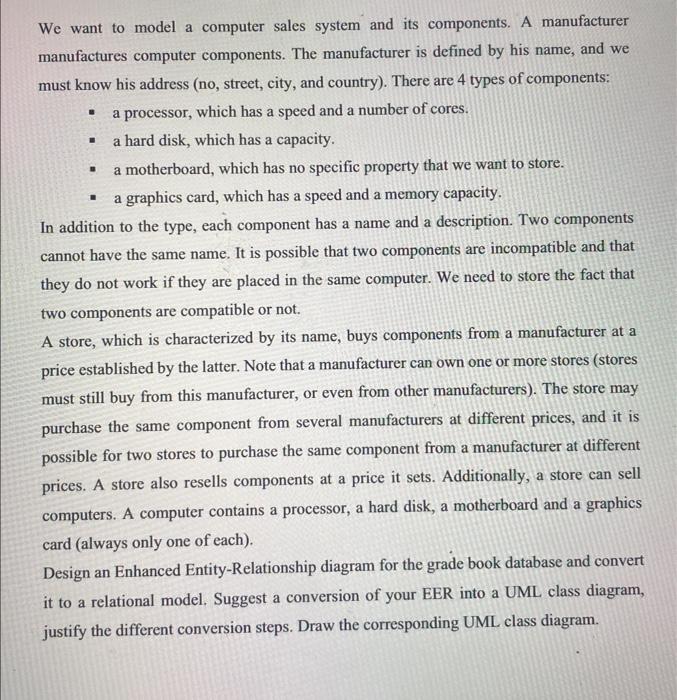Answered step by step
Verified Expert Solution
Question
1 Approved Answer
I am looking for the solution to the problem , where Enhanced Entity Relationship diagram is made using shapes eg. rectangles for entity and show
I am looking for the solution to the problem , where Enhanced Entity Relationship diagram is made using shapes eg. rectangles for entity and show disjoint constraint whereever applicable in addition to the conversion to relational model and then UML class diagram 
We want to model a computer sales system and its components. A manufacturer manufactures computer components. The manufacturer is defined by his name, and we must know his address (no, street, city, and country). There are 4 types of components: - a processor, which has a speed and a number of cores. - a hard disk, which has a capacity. - a motherboard, which has no specific property that we want to store. - a graphics card, which has a speed and a memory capacity. In addition to the type, each component has a name and a description. Two components cannot have the same name. It is possible that two components are incompatible and that they do not work if they are placed in the same computer. We need to store the fact that two components are compatible or not. A store, which is characterized by its name, buys components from a manufacturer at a price established by the latter. Note that a manufacturer can own one or more stores (stores must still buy from this manufacturer, or even from other manufacturers). The store may purchase the same component from several manufacturers at different prices, and it is possible for two stores to purchase the same component from a manufacturer at different prices. A store also resells components at a price it sets. Additionally, a store can sell computers. A computer contains a processor, a hard disk, a motherboard and a graphics card (always only one of each). Design an Enhanced Entity-Relationship diagram for the grade book database and convert it to a relational model. Suggest a conversion of your EER into a UML class diagram, justify the different conversion steps. Draw the corresponding UML class diagram 
Step by Step Solution
There are 3 Steps involved in it
Step: 1

Get Instant Access to Expert-Tailored Solutions
See step-by-step solutions with expert insights and AI powered tools for academic success
Step: 2

Step: 3

Ace Your Homework with AI
Get the answers you need in no time with our AI-driven, step-by-step assistance
Get Started


